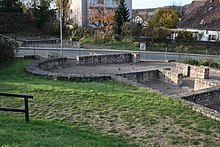Roman Hall (Bad Kreuznach)
The Roman Hall Museum in the town of Bad Kreuznach in Rhineland-Palatinate shows finds from a Roman palace villa from the late 2nd century AD as well as other finds from the Roman era from the Bad Kreuznach district . Underneath are two large mosaic floors , which are counted among the most important finds north of the Alps, as well as numerous stone monuments.
location
The museum is located at Hüffelsheimer Str. 11 in the Bangert manor in the vicinity of the Palace Park Museum and the Museum of Puppet Theater Culture . It can be reached by bus on line 203 towards Agnesienberg (Schlossparkmuseum stop). The building is equipped with a ramp for strollers and the severely disabled as well as a disabled toilet.
Roman palace villa
The core of the on-site exhibition are the archaeologically proven remains of a palace villa, which in terms of size, equipment and type of construction goes far beyond the usual form of rural settlement, so-called villa rustica . The facility first attracted the attention of research with the discovery of the gladiator mosaic in 1893. In the 1950s a road was built across the facility. After the discovery of another, the Oceanus mosaic, further excavations were carried out in the as yet undeveloped area from 1975 to 1980, funded by the German Research Foundation .
The excavations showed a four-wing building that was arranged around an uncovered inner courtyard ( peristyle villa ). It took up an area of 70 × 80 m and was built on a slope sloping to the north after the demolition of a previous building in the second half of the 2nd century AD. In the southern wing of the building there was a reception hall with an apse and fountain in the middle , where the Oceanus mosaic was also found. On the northern front of the building there was a porticus and kryptoporticus , and further porticos to the inner courtyard. More than 50 rooms were found on the ground floor alone, but the building was multi-storey due to the hillside location alone. The outbuildings of the complex have been little researched due to the recent development. The owner should belong to the elite of the Roman province, but details are unknown.
The villa was destroyed in the 3rd century between 260 and 275 AD. At the beginning of the 4th century a late antique fortress was built on the north side , but this was abandoned at the latest with the construction of the Valentinian fort Bad Kreuznach.
A model in the museum shows the palace villa as it was built in the high imperial era. Finds from the facility can be viewed on the gallery. In addition to luxurious parts of the furnishings such as glass windows and fragments of the wall painting, this also includes the residents' everyday objects, glass, cooking and fine tableware ( terra sigillata ) as well as various metal objects.
Outside the museum building, the reconstructed foundations of the palace villa can be viewed, including the central apse. Various display boards explain the location in the former villa.
Mosaic finds
The most important part of the exhibition are the two mosaics, which are no longer in their original position, but are centrally located in the museum building, protected from the weather.
The 58 m² large gladiator mosaic was found in 1893 and was soon one of the attractions of the spa town. The mosaic, which has been preserved over a large area, shows various fights from the Roman amphitheater , fights between gladiators , fights against animals and between animals in 13 image fields . A staircase leads to the side of the basement, where the function of Roman underfloor heating ( hypocaust ) is explained.
In 1966 a second mosaic was discovered, the 68 m² Oceanus mosaic. It comes from the central apse of the villa and shows the sea god, ship and port scenes, Mediterranean architecture and many sea animals that come from the Mediterranean. Remnants of an inscription with the name of a consul presumably date the mosaic to the year 234 AD. In the center there is a marble-clad water basin, which was reconstructed based on excavation findings. Oceanus itself is in the semicircular apse, which is interpreted as a triclinium .
Stone monuments
On the ground floor, in addition to the mosaics, Roman stone monuments from the district and the city of Bad Kreuznach are shown. These include giant columns of Jupiter , votive stones and dedicatory inscriptions - some of them spolia that were walled up in the foundation walls of the late antique fort. The late antiquity is documented by stone sarcophagi , which can also be assigned to the late antique fort Bad Kreuznach.
Soldier gravestones from Bingerbrück
The gravestones from Bingerbrück represent a special group in the exhibition of stone monuments . They come from soldiers from Bingen who were buried north of the Nahe , as is common with the Romans, along the arteries. These are tombstones of auxiliary troops, some come from remote Roman provinces, such as Tiberius Iulius Abdes Pantera from Sidon .
literature
- Sabine Hornung : Luxury in the country - The Roman palace villa of Bad Kreuznach. Bad Kreuznach 2008, ISBN 978-3-00-024822-1 .
- Gerd Rupprecht : Bad Kreuznach KH. Manor house of a country estate. In: Heinz Cüppers (Hrsg.): The Romans in Rhineland-Palatinate. 3. Edition. Reprint Nikol, Hamburg 2005, ISBN 978-3-933203-60-1 , pp. 321-323.
- Vera Rupp , Heide Birley: Summer and winter surrounded by luxury. In: V. Rupp, H. Birley (ed.): Country life in Roman Germany. Theiss, Stuttgart 2012, ISBN 978-3-8062-2573-0 , pp. 136f.
Web links
Coordinates: 49 ° 50 ′ 44.6 " N , 7 ° 50 ′ 48.5" E






